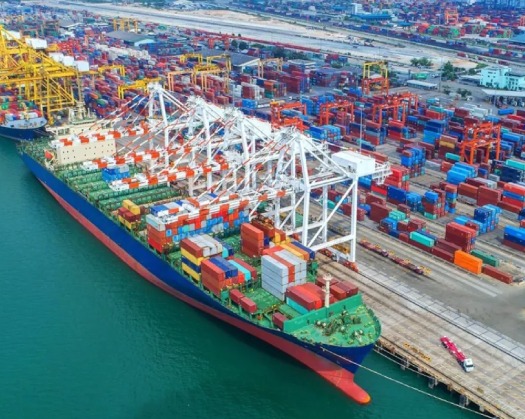New Delhi: A notable transformation in global trade patterns has occurred, as the United States has progressively decreased its garment imports from China over the last ten years.
This reduction, driven by the US-China trade conflict and rising concerns regarding human rights issues in China, has created opportunities for other Asian nations to enhance their foothold in the American apparel sector.
A recent report from the United States International Trade Commission (USITC) indicates that China's market share in US garment imports has dropped by 16.4 percent from 2013 to 2023, marking a significant decline for a country that was once the leading supplier.
In contrast, countries such as Vietnam, Bangladesh, India, and Cambodia have emerged as key beneficiaries of this market shift.
China's previous stronghold in the US apparel market was largely due to its extensive production capabilities, streamlined supply chains, and competitive pricing, making it the preferred choice for American retailers.
However, various factors have contributed to the erosion of China's market share over the past decade.
The US-China trade war, which commenced in 2018 during the Trump administration, imposed tariffs on a vast array of Chinese goods, including apparel. These tariffs have considerably raised the costs associated with importing garments from China, leading US companies to seek alternative sourcing solutions.
Human rights issues: Reports of forced labor in the Xinjiang region of China, a major area for cotton production, have sparked significant international outrage.
In response, the United States implemented the Uyghur Forced Labor Prevention Act in 2021, which prohibits the importation of goods produced with forced labor from Xinjiang.
This law has further discouraged American companies from procuring clothing from China.
Increasing labor costs: As China's economy has developed, wages have increased, reducing its competitiveness relative to other low-cost garment-producing countries in Asia.
While this shift has been detrimental to China, it has opened up avenues for other Asian nations to boost their exports to the United States.
These countries have utilized their advantages to occupy the market space left by China.
Vietnam: Vietnam has emerged as the primary beneficiary, reinforcing its status as a leading supplier to the U.S. apparel market.
Its geographical closeness to China has enabled it to take advantage of established supply chain networks while providing more competitive pricing.
Moreover, Vietnam has entered into free trade agreements with significant global partners, such as the Comprehensive and Progressive Agreement for Trans-Pacific Partnership (CPTPP), further enhancing its market position.
Bangladesh: Renowned for its proficiency in ready-made garment production, Bangladesh has strengthened its presence in the US market by providing competitive pricing and extensive production capabilities. Investments in sustainability and adherence to international labor standards have further enhanced its attractiveness to American buyers.
India: India has positioned itself as a formidable player, particularly in the cotton apparel and textiles sectors. Government initiatives, including the Production Linked Incentive (PLI) scheme, along with a commitment to boosting manufacturing capacity, have empowered Indian exporters to capitalize on the opportunities arising from China's diminishing market share.
Cambodia: The garment industry in Cambodia has also experienced growth, largely due to preferential trade agreements and favorable labor costs. Despite facing challenges such as inadequate infrastructure, the nation has successfully drawn in US buyers looking for alternatives to China.
The shifting market share among Asian nations carries significant consequences for the global apparel sector.
Supply chain diversification: US companies are increasingly implementing a "China plus one" strategy, diversifying their supply chains to lessen reliance on a single nation. This approach not only reduces risks linked to geopolitical tensions but also enhances resilience against disruptions, such as those experienced during the Covid-19 pandemic.
Increased competition among exporters: The race among countries to capture a larger share of the US apparel market has intensified, particularly among Asian exporters.
This competitive landscape has prompted nations to enhance their quality, sustainability, and compliance standards.
Emphasis on sustainability: Sustainability has emerged as a critical priority for US retailers, who face increasing demands from consumers and regulators to implement ethical sourcing practices.
Countries such as Bangladesh and India have reacted by investing in eco-friendly technologies and sustainable manufacturing methods, thereby increasing their attractiveness.
The Trump factor: Anticipating uncertainty
With Donald Trump poised to commence his new term in January 2025 following a significant electoral victory, analysts are keenly observing the potential effects of his administration on US-China trade relations and the overall apparel market.
Renewed tariffs and trade restrictions: Trump's initial term was characterized by a stringent stance on China, including the introduction of tariffs that disrupted global trade dynamics.
As he returns to office, similar strategies may further diminish US garment imports from China, creating opportunities for alternative suppliers in Asia.
Focus on domestic manufacturing: Trump's "America First" policy prioritized the enhancement of domestic manufacturing capabilities.
The likelihood of the US emerging as a significant garment producer remains low due to elevated labor costs; however, policies promoting reshoring may influence import trends.
Increased examination of human rights issues: A Trump administration could maintain or even escalate its focus on China's human rights record, potentially resulting in stricter import regulations from the nation.
This situation may compel US companies to shift away from Chinese suppliers.
Nevertheless, emerging exporters in Asia face their own set of challenges.
Countries such as Vietnam, Bangladesh, India, and Cambodia have successfully gained market share, yet they encounter obstacles in sustaining and growing their presence, including issues related to infrastructure, geopolitical uncertainties, and compliance expenses.
The reduction of US garment imports from China signifies a crucial transformation in global trade dynamics, influenced by geopolitical tensions, human rights issues, and economic considerations.
While this shift has opened doors for other Asian nations, the path forward is laden with difficulties, ranging from infrastructure constraints to compliance challenges.
Currently, Vietnam, Bangladesh, India, and Cambodia are capitalizing on this transition, highlighting the necessity of adaptability and resilience in navigating the complexities of global trade.












